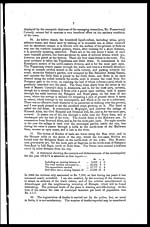Medicine - Institutions > Army health reports and medical documents > Reports on military cantonments and civil stations in the Presidency of Bombay inspected by the Sanitary Commissioner in the years 1875 and 1876 > Part II - Reports on civil stations inspected in 1875
(303) Page 6
Download files
Individual page:
Thumbnail gallery: Grid view | List view

6
north-east, from 1/2 to 11/4 mile from the town. There is also a large tanning
manufactory belonging to a Bora, situated on the south-west, nearly a mile and
a-half a way.
27. The water-supply is derived from wells constructed during. Mahomedan
rule, situated at distances varying from 5 to 6 miles from the city, and brought
into it by three conduits, consisting of earthen pipes laid in masonry, two of
which are situated on the north-east, near a village called Kapurwadi.
The first is called the Kapurwadi Aqueduct, and after supplying four cisterns
in the native infantry lines, and giving a branch to the Kotla, it passes into the
town and supplies 10 dipping-wells. The Nagabae, which has its source also at
Kapurwadi, and which has only lately been repaired and restored at a cost of
Rs. 60,000, of which sum Government contributed a quarter, and Mr. Dinshaw
Maneckjee Petit of Bombay gave another Rs. 15,000, the remaining half being
paid for by the municipality out of town duties. It supplies 12 cisterns. The
third aqueduct, brought from wells near a village called Wadgaon, about 6 miles
distant on the north-east of the city, supplies 33 cisterns, and the water is said
to be most excellent. The open dipping-wells, by which the drinking-water in
Ahmednagar is distributed, are, however, objectionable, as they allow all kinds of
impurities to be mixed with it. For example, at the time of my visit at the Gunj
Fountain, there was only about one foot of water in it. This is supplied by the
Kapurwadi Aqueduct, and at the bottom were seen mud, leaves, stalks of Indian
corn, bottles, flowers, paper, &c. The same objectionable condition was observed
in other dipping-wells. The quantity of water brought in by these aqueducts is
estimated to amount to about 10 or 12 gallons per head of population. There
are many wells in the town, and water was seen in them at a depth of 35 to 40
feet; but it is not potable, being brackish.
28. There are three covered market-places belonging to the municipality
near the Gunj: one for the sale of green vegetables, one for groceries, and the
third for petty trades; and inside the walls in Kappurpura, in the north-eastern
division, is a mutton-market belonging to the municipality, which contains 27
stalls.
The slaughter-house for sheep is at the back. It is paved and drained, and
at the time of my visit, before the day's work began, it was perfectly clean, al-
though there was an offensive smell from the tub in which the offal is kept before
it is carted away. Thirty-five to forty sheep are daily slaughtered here. At the
back of one of the rows of mutton-stalls, and approached from the street by a
separate gate, is a raised platform where dry and salt fish are sold. Outside the
walls, between the Mungulwar and Surjapur Gates, is the beef-market, with 8 stalls.
It was not clean at the time of my visit, as bones were lying about; and its site has
not been judiciously chosen, as it is, in my opinion, too close to the Native Infantry
latrines, between the walls and the Kotla. The slaughter-house for cattle, situated
at the head of a nulla at Waitagwadi, is built of stone, and is enclosed by a wall,
and is paved. About 8 oxen are slaughtered daily. The offal and blood are
taken in carts to the neighbouring public latrines, and buried in the same pits as
the nightsoil; but the offensive washings from the paved floor escape at the rear,
and are received, first of all, into a cesspit, which retains some of the coagulated
blood, whilst the fluid part flows into the nulla above referred to, which is about
half a mile to windward of the tombs known by the name of "The Two Sisters,"
where the Session Judge has his residence.
29. There are about 75 kerosine-oil lamps in the main streets, which, during
the months of April and May, are watered daily; and I was much pleased at the
general cleanliness of the surface inside the city. In fact, I have never seen
greater attention paid to this most important duty; and the roads and bye-lanes
were well swept, and every privy served by municipal halalcores that I inspected,
was more than fairly clean. It appeared to me that the municipality do all in
their power to keep the place as clean as the present faulty arrangements permit,
and the zealous and intelligent interest in all matters connected with the city
Set display mode to: Large image | Zoom image | Transcription
Images and transcriptions on this page, including medium image downloads, may be used under the Creative Commons Attribution 4.0 International Licence unless otherwise stated. ![]()
| Permanent URL | https://digital.nls.uk/75009463 |
|---|




